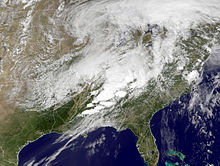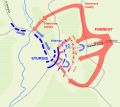Portal:Mississippi
 | |
 | |
Mississippi (/ˌmɪsɪˈsɪpi/ ⓘ MISS-iss-IP-ee) is a state in the Southeastern region of the United States. It borders Tennessee to the north, Alabama to the east, the Gulf of Mexico to the south, Louisiana to the southwest, and Arkansas to the northwest. Mississippi's western boundary is largely defined by the Mississippi River, or its historical course. Mississippi is the 32nd largest by area and 35th-most populous of the 50 U.S. states and has the lowest per-capita income. Jackson is both the state's capital and largest city. Greater Jackson is the state's most populous metropolitan area, with a population of 591,978 in 2020. Other major cities include Gulfport, Southaven, Hattiesburg, Biloxi, Olive Branch, Tupelo, Meridian, and Greenville.
The state's history traces back to around 9500 BC with the arrival of Paleo-Indians, evolving through periods marked by the development of agricultural societies, rise of the Mound Builders, and flourishing of the Mississippian culture. European exploration began with the Spanish in the 16th century, followed by French colonization in the 17th century. Mississippi's strategic location along the Mississippi River made it a site of significant economic and strategic importance, especially during the era of cotton plantation agriculture, which led to its wealth pre-Civil War, but entrenched slavery and racial segregation. On December 10, 1817, Mississippi became the 20th state admitted to the Union. By 1860, Mississippi was the nation's top cotton-producing state and slaves accounted for 55% of the state population. Mississippi declared its secession from the Union on January 9, 1861, and was one of the seven original Confederate States, which constituted the largest slaveholding states in the nation. Following the Civil War, it was restored to the Union on February 23, 1870. Mississippi's political and social landscape was dramatically shaped by the Civil War, Reconstruction era, and civil rights movement, with the state playing a pivotal role in the struggle for civil rights. From the Reconstruction era to the 1960s, Mississippi was dominated by socially conservative and segregationist Southern Democrats dedicated to upholding white supremacy.
Despite progress, Mississippi continues to grapple with challenges related to health, education, and economic development, often ranking among the lowest in the United States in national metrics for wealth, health care quality, and educational attainment. Economically, it relies on agriculture, manufacturing, and an increasing focus on tourism, highlighted by its casinos and historical sites. Mississippi produces more than half of the country's farm-raised catfish, and is a top producer of sweet potatoes, cotton and pulpwood. Others include advanced manufacturing, utilities, transportation, and health services. Mississippi is almost entirely within the east Gulf Coastal Plain, and generally consists of lowland plains and low hills. The northwest remainder of the state consists of the Mississippi Delta. Mississippi's highest point is Woodall Mountain at 807 feet (246 m) above sea level adjacent to the Cumberland Plateau; the lowest is the Gulf of Mexico. Mississippi has a humid subtropical climate classification.
Mississippi is known for its deep religious roots, which play a central role in its residents' lives. The state ranks among the highest of U.S. states in religiosity. Mississippi is also known for being the state with the highest proportion of African-American residents. The state's governance structure is based on the traditional separation of powers, with political trends showing a strong alignment with conservative values. Mississippi boasts a rich cultural heritage, especially in music, being the birthplace of the blues and contributing significantly to the development of the music of the United States as a whole. (Full article...)

The 2011 Super Outbreak was the largest, costliest, and one of the deadliest tornado outbreaks ever recorded, taking place in the Southern, Midwestern, and Northeastern United States from April 25 to 28, 2011, leaving catastrophic destruction in its wake. Over 175 tornadoes struck Alabama, Mississippi, and Tennessee, which were the most severely damaged states. Other destructive tornadoes occurred in Arkansas, Georgia, Kentucky, Louisiana, New York, and Virginia, with storms also affecting other states in the Southern and Eastern United States. In total, 367 tornadoes were confirmed by NOAA's National Weather Service (NWS) and Government of Canada's Environment Canada in 21 states from Texas to New York to southern Canada. Widespread and destructive tornadoes occurred on each day of the outbreak. April 27 was the most active day, with a record 223 tornadoes touching down that day from midnight to midnight CDT (05:00–05:00 UTC). Four of the tornadoes were rated EF5, which is the highest ranking on the Enhanced Fujita scale; typically these tornadoes are recorded no more than once a year.
In total, 348 people were killed as a result of the outbreak, including 324 tornado-related deaths across six states and 24 fatalities caused by other thunderstorm-related events such as straight-line winds, hail, flash flooding or lightning. In Alabama alone, 238 tornado-related deaths were confirmed by the Storm Prediction Center (SPC) and the state's Emergency Management Agency. April 27's 316 fatalities were the most tornado-related fatalities in the United States in a single day since the "Tri-State" outbreak on March 18, 1925 (when at least 751 people were killed). Nearly 500 preliminary local storm reports were received for tornadoes over four days, including 292 in 16 states on April 27 alone. This event was the costliest tornado outbreak in United States history, with total damage reaching $10.2 billion (equivalent to $14 billion in 2023). In 2023, tornado expert Thomas P. Grazulis created the outbreak intensity score (OIS) as a way to rank various tornado outbreaks. The 2011 Super Outbreak received an OIS of 378, making it the second most intense tornado outbreak in recorded history behind only the 1974 Super Outbreak. (Full article...)
- ... that a section of Mississippi Highway 489 was designated as the Jason Boyd Memorial Highway to commemorate the MDOT superintendent who was killed while removing debris from the road?
- ... that it cost an estimated $1.2 million to move the Confederate Monument at the University of Mississippi?
- ... that Carey Wright implemented literacy reforms that led to the "Mississippi Miracle"?
- ... that Rodney, Mississippi, became a ghost town after the Mississippi River shifted about two miles (3.2 km) away?
- ... that police in Indianola, Mississippi, shot an unarmed 11-year-old African-American boy after responding to his 9-1-1 call for help at his home?
- ... that Rubel Phillips was the first Republican to run in the Mississippi gubernatorial election since 1947 when he ran in 1963?
- ... that the Coon Rapids Dam on the Mississippi River is the northern terminus of the river's navigable portion?
- ... that Bdóte, an area of sacred significance to the Dakota people, centered on the confluence of the Minnesota and Mississippi rivers, was also the site of their forced exile from Minnesota?

A tow entering the downstream side of the Jamie Whitten Lock and Dam on the Tennessee–Tombigbee Waterway in Tishomingo County, Mississippi. When the tow exits the lock on the upstream side, it will be in Bay Springs Lake

|
Hello! As a past or current member of WikiProject Mississippi, a WikiProject dedicated to developing and improving articles about Mississippi, you are cordially invited to edit, assess, and improve our coverage of all things Mississippi on Wikipedia! |
Topics: Constitution - Supreme Court - History - Music
Regions: Golden Triangle - Mississippi Plain - Mississippi Delta - Mississippi Gulf Coast - Natchez District - Pine Belt - Tennessee Valley
Cities: Biloxi - Clarksdale - Clinton - Columbus - Greenville - Gulfport - Hattiesburg - Jackson - Meridian - Olive Branch - Pascagoula - Pearl - Ridgeland - Southaven - Starkville - Tupelo - Vicksburg
Geography: Rivers - Lakes - Mountains - National forests - Islands - Wilderness areas - Natural disasters - Parks - State Parks
Industries: Agriculture - Oil
CDPs: Byram - Diamondhead - Kiln - Lyman - Pearlington - Saucier - Shoreline Park - West Hattiesburg
Metros: Gulfport‑Biloxi - Hattiesburg - Jackson - Memphis - Pascagoula
Statistics: Population
Lists: Mississippi-related lists
| Nickname | The Magnolia State |
|---|---|
| Motto | Virtute et armis (Latin) transl. By Valor and Arms |
| Flower | Magnolia |
| Rock | Petrified wood |
| Toy | Teddy bear |
| Other | Mississippi Symbols for more |
 |
Here are some tasks awaiting attention:
|
The following Wikimedia Foundation sister projects provide more on this subject:
-
Commons
Free media repository -
Wikibooks
Free textbooks and manuals -
Wikidata
Free knowledge base -
Wikinews
Free-content news -
Wikiquote
Collection of quotations -
Wikisource
Free-content library -
Wikispecies
Directory of species -
Wikiversity
Free learning tools -
Wikivoyage
Free travel guide -
Wiktionary
Dictionary and thesaurus
| Official State of Mississippi website |
- Mississippi Governor
- Mississippi Lieutenant Governor
- Mississippi Attorney General
- Mississippi Secretary of State
- Mississippi State Auditor
- Mississippi State Treasurer
- Mississippi State Insurance Commissioner
- Mississippi State Supreme Court
- Mississippi State Legislature
- U.S. Census Bureau Mississippi Data
- USDA Mississippi Statistical Facts
- USGS real-time, geographic, and other scientific resources of Mississippi









































